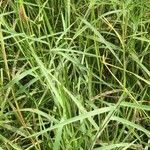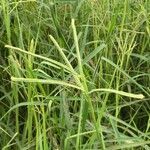Loosely tufted, erect or decumbent perennial, 100-700 mm high, occasionally a hydrophyte; shortly rhizomatous, sometimes stoloniferous; culm nodes glabrous. Leaf blade 150-200(-380) x 6-8(-10) mm; ligule an unfringed membrane. Inflorescence of 1-5 secund racemes, digitate or on elongated central axis; rachis flat, linear, almost leaflike; spikelets borne singly, arranged in 2 rows; upper lemma facing rachis. Spikelets 2.0-2.5 x 1.8-2.4 mm, ovate, dorsiventrally compressed, awnless, green becoming brown, glabrous; glumes unequal; lower glume absent; upper glume papery, 3-nerved. Florets 2; lower floret sterile, lemma equal, similar to upper glume but flat on back, median nerve present; upper floret bisexual, lemma hard, finely striate, obtuse, entire, faintly nerved, glabrous, margins narrow and inrolled, clasping only edges of palea, brown at maturity; anther 0.5-0.8 mm long. Flowering time Sept.-May.
Perennial; culms 10–150 cm. high, 1–6 mm. in diameter, 2–17-noded, the nodes commonly exposed, erect, or ascending from a decumbent base and rooting at the lower nodes.. Leaf-blades linear, 5–40 cm. long, 3–15 mm. wide, tapering to a filiform tip.. Inflorescence composed of 1–20 racemes, these digitate or borne on an axis up to 8 cm. long, the longest raceme 4–15 cm. long, with spikelets borne singly on a ribbon-like rhachis 1–2.5 mm. wide.. Spikelets broadly elliptic, obovate or suborbicu-lar, 1.4–3 mm. long, green becoming brown; lower glume absent; upper glume papery; lower lemma similar or rarely coriaceous, 3–5-nerved (in the latter case the nerves evenly spaced or the laterals close together); upper lemma finely striate, brown at maturity.. Fig. 142.
Loosely tufted, erect or decumbent perennial 100-700 mm high, occasionally a hydrophyte; rhizome short, sometimes stoloniferous; culm nodes glabrous. Leaf blade 150-200(-380) x 6-8(-10) mm, ligule 2-8 mm long, conspicuous. Inflorescence of 1-5 racemes, 30-80(-150) mm long; rachis flat and linear, almost leaf-like; spikelets arranged in two rows, secund. Spikelet 2.0-2.5 x 1.8-2.4 mm, ovate, green becoming brown, glabrous; lower glume absent; upper glume 3-nerved, papery; upper lemma finely striate, brown at maturity; anther 0.5-0.8 mm long.
A millet grass. It is an annual or perennial grass. It has short rhizomes. The stems are tufted. It grows up to 1 m high. The leaves are in two rows. The leaf blade is long and flat. It is 45 cm long by 2.5 cm across. The flower stalk has 2-5 alternate spikes. These do not have stalks. Several varieties are recognised. The kind cultivated for seeds is used as an annual and has larger seeds. The grain is in a hard husk which is difficult to remove.
Perennial, hydrophyte (occasionally) or rhizomatous (shortly) or stoloniferous (sometimes) or tufted (loosely, erect or decumbent), up to 0.7 m high. Leaf blades 150-200 (-380) mm long, 6-8(-10) mm wide. Spikelets 2.0-2.5 mm long, 1.8-2.4 mm wide. Racemes 1-5, 30-80(-150) mm long; rhachis linear and almost as wide as raceme; spikelets glabrous, ovate, arranged in 2 rows.
Perennial; up to 0.7 m high; occasionally hydrophyte; or shortly rhizomatous; or sometimes stoloniferous; or loosely tufted. Culms erect or decumbent. Leaf blades 150-200(-380) x 6-8(-10) mm. Flowers: racemes digitate; 1-5; 30-80(-150) mm long; rachis flat; linear and almost as wide as raceme; spikelets 2.0-2.5 x 1.8-2.4 mm; glabrous; ovate; arranged in 2 rows.
Racemes 1–20, digitate or borne on an axis up to 8 cm. long, the longest raceme 4–15 cm. long, the spikelets borne singly on a rhachis 1–2.5 mm. wide.
Culms 10–150 cm. high, 1–6 mm. in diam., the nodes mostly exposed, erect or ascending from a decumbent base and rooting at the nodes below.
Leaf laminae 5–40 cm. long, 3–15 mm. wide, linear, tapering to a filiform apex.
Spikelets 1.4–3 mm. long, broadly elliptic to subrotund, green becoming brown.
Inferior lemma papery or rarely coriaceous, glabrous.
Superior lemma brown at maturity.
Inferior glume absent.
Perennial.



